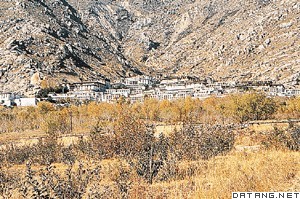1) Gelugpa Temple


格鲁派寺院
2) Gelug sect


格鲁派
1.
Link between Tuerhute Mongolia in the Volga River Basin and Elite of Gelug Sect of Tibetan Buddhism
伏尔加河流域土尔扈特蒙古与西藏格鲁派上层联系述考
2.
Based on the theory of "origin and essence is nothing",Gelug sect discriminated the secret scriptures and teachings from the open scriptures and teachings,and established a special ideological criticism of Buddhism which is a different thought from the other sects.
格鲁派基于"缘起自性空"的思想理论,对显密经典和教法进行分别,形成了不同于其他宗派的判教思想。
3) Dge-lugs-pa


格鲁派
1.
The Study of Dge-lugs-pa s Philosophic Thought of Tibetan Buddhist;


藏传佛教格鲁派的哲学思想研究
5) temple
[英]['templ] [美]['tɛmpḷ]


寺院
1.
The Eunuchs and Buddhist temples in the Northern Wei Dynasty;


北魏宦官与佛教寺院述略
2.
Culture of Buddhist Temple and the Creation of Poetry in the Tang Dynasty;


唐代佛教寺院文化与诗歌创作
6) temples
[英]['templ] [美]['tɛmpḷ]


寺院
1.
In “Qingming Shanghe Tu” (“The Outing at Bian River on Qingming Festival”), Zhang Zeduan depicted plenty of architectures in and out of Dongjing and the outskirt nearby, specifically like temples, official mansions, street stores, etc, which appeared during the reign of Huizong, the emperor of Northern Song Dynasty.
张择端在《清明上河图》中描绘了北宋徽宗宣政前后东京城内、城郊的大量建筑形象,具体有寺院、官宅、临街店肆等。
2.
According to its production and management style,it can be divided into three management modes,that is,ranch,farmland and the land around the temples.
寺院土地是清代蒙古地区土地所有制形态的重要类型,也是清代蒙古寺院经济中的重要生产资料之一。
3.
There were many temples and monks and there were frequent and close relationships between the government and the temples.
西夏以佛教为国教,寺院林立、僧人众多,政府与僧团交往频繁、关系密切。
补充资料:格鲁派
| 格鲁派 中国藏传佛教宗派。藏语格鲁意即善律,该派强调严守戒律,故名。该派僧人戴黄色僧帽,故又称黄教。创教人宗喀巴,原为噶当派僧人,故该派又被称为新噶当派。宗喀巴曾师从14世纪西藏各大教派如萨迦、噶举等,他针对藏传佛教中当时僧纪废弛、寺院生活腐化,而倡导宗教改革,提出僧人严格持戒、不事农作、独身不娶,并加强僧院制度管理。关于修持,他主张显密并重,先显后密,强调教理和因明等都有助于解脱。其《菩提道次第广论》、《修宗道次第广论》与阿底峡《菩提道灯论》在旨趣上一脉相承。1409年,宗喀巴在帕竹地方政权支持下,在拉萨发起大祈愿法会,显示其权威地位。同年建甘丹寺为主寺,故该派亦称甘丹派 。以后该派又建哲蚌寺、色拉寺、扎什伦布寺等诸大寺,势力日渐扩张。1542年,该派以锁南嘉错为二世达赖的转世,活佛转世制度在格鲁派中自此确立。16世纪锁南嘉错受明廷册封。至清代,该派的达赖与班禅两转世系统均由清廷扶持确认。格鲁派成为西藏地方政权的执政教派,西藏政教合一的统治形式自此进一步发展。格鲁派除藏区四大寺,尚有青海的塔尔寺、甘肃的拉卜楞寺及今蒙古的额尔德尼召等教派中心。该派奉龙树《中论》,持缘起性空之见。谓诸法待缘而起,毕竟空无自性。修持主教行并重,不废戒律,兼重止观。教法包容显密二宗,强调先显后密,循序渐进,学不躐等 。其学经制度严密系统,考核升迁皆有章法可循。显宗学僧先通五大部(《 量释论 》、《现观庄严论》、《入中论》、《戒律本论》、《俱舍论》),在三大寺获格西学位后方可进一步修密宗四大部瑜伽密法。该派亦有严格寺院管理制度,僧职人员各司其职,母子寺院从属关系严格。历史上该派在藏族、蒙古族居住区流传甚广,影响很大。
|
说明:补充资料仅用于学习参考,请勿用于其它任何用途。
参考词条
